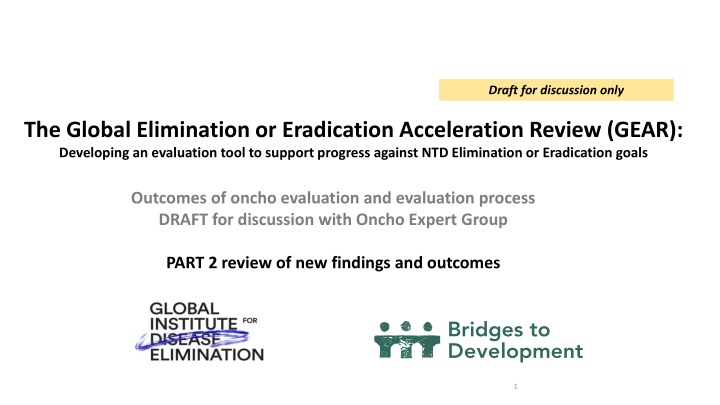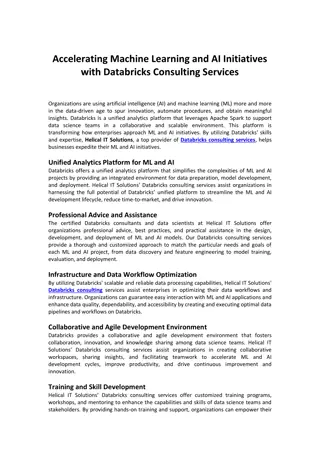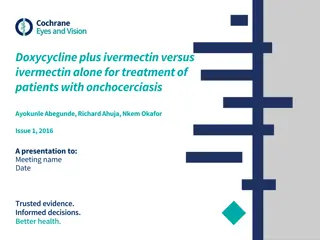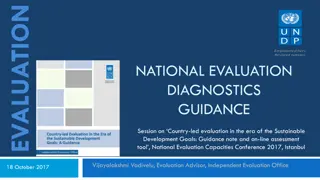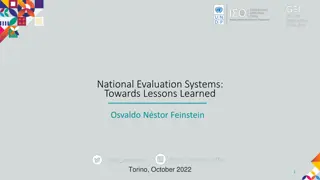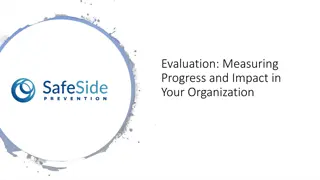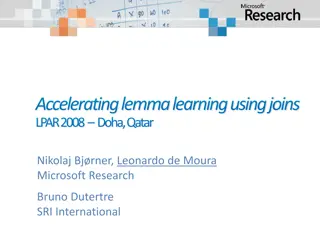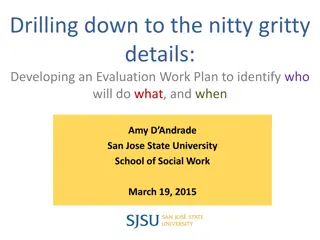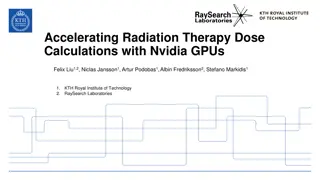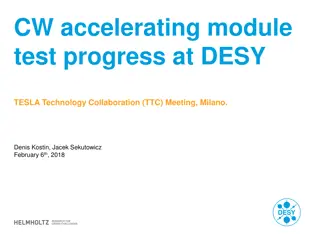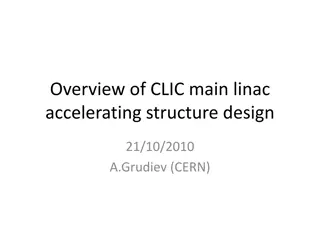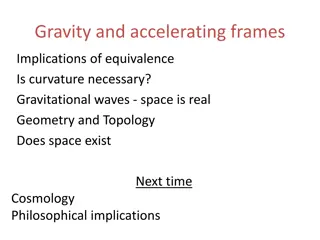Accelerating Progress in Onchocerciasis Evaluation and Presentation Strategies
Facilitating discussions on final evaluation outcomes and packaging strategies for stakeholder acceptance and utilization in global onchocerciasis programs. Review key findings, process feedback, and guidance to enhance implementation effectiveness.
Download Presentation

Please find below an Image/Link to download the presentation.
The content on the website is provided AS IS for your information and personal use only. It may not be sold, licensed, or shared on other websites without obtaining consent from the author.If you encounter any issues during the download, it is possible that the publisher has removed the file from their server.
You are allowed to download the files provided on this website for personal or commercial use, subject to the condition that they are used lawfully. All files are the property of their respective owners.
The content on the website is provided AS IS for your information and personal use only. It may not be sold, licensed, or shared on other websites without obtaining consent from the author.
E N D
Presentation Transcript
Draft for discussion only The Global Elimination or Eradication Acceleration Review (GEAR): Developing an evaluation tool to support progress against NTD Elimination or Eradication goals Outcomes of oncho evaluation and evaluation process DRAFT for discussion with Oncho Expert Group PART 2 review of new findings and outcomes 1
SUMMARY OF ONCHO EXPERT MEETING GOAL SUMMARY OF ONCHO EXPERT MEETING GOAL Goal for today with your input: Discuss the final outcomes of the oncho evaluation and evaluation process Discuss how to package the final outcomes to effectively present recommended areas for improvements that will increase the likelihood of stakeholders accepting and using the recommendations for planning and decision making in the global oncho program Agenda Brief review of lessons from E&E program- GEAR s origination Brief review of GEAR s process Recall of survey results Discuss focus group and interview results Discuss GEAR s presentation for recommended areas for improvements
Process of the review and how it worked and future use GEAR Feedback Results of the oncho specific review with feedback on partnership and program
COMPILING PROCESS GUIDANCE COMPILING PROCESS GUIDANCE 1 2 Meeting agendas GEAR Process Guide Survey Templates LINKS TO RESOURCES GEAR PROCESS GUIDE Examples from oncho GEAR process developed in 2020-2021 Template examples which can be applied to other diseases Guiding principles Step-by-step descriptions Detailed sub-tasks Expected outcomes Tips based on our early lessons learned 4
SEVEN STRATEGIC LESSONS FROM ELIMINATION AND SEVEN STRATEGIC LESSONS FROM ELIMINATION AND ERADICATION PROGRAMS ERADICATION PROGRAMS 1. Know and test your assumptions 2. Understand the context-specific infrastructure 3. Engage communities and adapt locally 4. Continuously test and adapt your tools 5. Expect the unexpected 6. People and partnership matter 7. Think about and plan for the last mile
FOCUS GROUPS AND INTERVIEWS FOCUS GROUPS AND INTERVIEWS Focus Groups: Interviews: Maria Rebollo, WHO National Oncho Elimination Committees (NOECs) Country Program Managers (French, English, Portuguese separately) Last Mile/ End Game Countries Daniel Dagne & Dieudonne Sankara, WHO Yao Sodahlon, MDP Jamie Tallant, Reaching the Last Mile/ END Fund Christy Hanson, BMGF Vector/ Environmental Control Researchers
RESULTS OF THE FOCUS GROUPS AND INTERVIEWS RESULTS OF THE FOCUS GROUPS AND INTERVIEWS Strong support for: Coordinated global level partnership Updated strategy for oncho elimination Harmonized research agenda WHO requests results presented on two elements: Partnership Program
PARTNERSHIP PARTNERSHIP No global partnership on oncho Multiple smaller partnerships may exist by NOT global partnership Smaller partnerships provide good examples to pull from to inform global partnership
PROGRAM PROGRAM Lack of Standardization & Community Data Program funding fractionated- different thing available in different places based on resources and partners A lot of heterogeneity in program implementation Each country, partner, and funder are independent actors making decisions about program elements NOECs separate with no forum to connect & share Outdated data used to direct programs Need for more timely data to drive decision making Capacity Building Need for capacity building, particularly in vectors and labs Country Situations Guidance Poor political will in lagging countries Lusophone countries left behind Hardest places left behind Lacking/inadequate interim guidance for programs in particular WRT vectors and post treatment/elimination surveillance
STRATEGIC BLIND SPOTS STRATEGIC BLIND SPOTS No strategy/ plans to: Detect changes in transmission- transmission assumed stable Detect cases or transmission outside of specified areas (outliers) Detect re-emergence Detect changes in efficacy or sensitivity of tools
GEAR Draft Recommended Areas For Improvements
ASSETS ASSETS Dedicated partners A lot of experience Well understood program gaps and weaknesses Desire for stronger partnership and leadership Opportunities/lessons to learn from the heterogeneity of the program approaches over the last few years
GUIDANCE FOR STRONG E&E PROGRAM GUIDANCE FOR STRONG E&E PROGRAM Research Agenda Strategy Partnership Define the stages of the program and interventions for each stage Plan for the last mile Engage all stakeholders in partnership towards the shared goal Mechanism to communicate across all levels of the program to share experience and learn Engage communities and adapt locally Process to quickly adapt and scale up new interventions or tools Mitigate risks and share successes Share challenges and issues for research agenda Define the M&E strategy Define ways to detect and understand the unexpected Guidance for decision on moving from one program stage to another Know and test assumptions Continually adapt and test tools Understand the context- specific infrastructure and how to adapt Consider local adaptation for broader application Develop tools for all stages of the program Quickly adapt and guide scale up of new tools or interventions with M&E Define criteria for decision on moving from one program stage to another
PARTNERSHIP PARTNERSHIP- - WHAT IS WANTED WHAT IS WANTED Info and experience sharing (local, national, global) Clarify roles & responsibilities and define the partnership Pulling from past experience with elements from OEPA, APOC Shared protocols Program review Sharing across programs Cross border discussions Group problem solving Strong TA to individual programs annually reviewed Capacity support Data management Political will generation Vector support Lab capacity
STRATEGY STRATEGY- - WHAT IS WANTED WHAT IS WANTED To improve strategy learning from the field experience Include approaches for all aspects of the transmission cycle To support adaptation to local contexts To get new tools to field more efficiently To improve detection of changes in transmission and potential resistance with response to the changes included in the strategy To improve communication between all levels and clarity on partnership
RESEARCH AGENDA TO SUPPORT ELIMINATION RESEARCH AGENDA TO SUPPORT ELIMINATION GOAL GOAL- - WHAT IS WANTED WHAT IS WANTED Target research on main program needs focused on decision making between program stages Allow research to be conducted for cross comparison and compiling of results across studies to accelerate guidance to programs Support access to resources for priority issues Facilitate annual review of progress, identification of new issues and collaboration
QUESTIONS QUESTIONS Is this feedback helpful? Will it help start the conversation with the oncho community to strengthen the program? WHO wants to have this presented as part of their next steps. What should we present and when to the oncho community? Proposal: high level feedback on the process and then on the outcomes for oncho. When and how? Atlanta meeting? Other? How has the process been helpful and constructive? Do you have feedback on how to improve the process?
